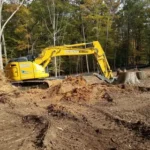A commercial roof is one of the most important structural elements of any business premises. It serves as the first line of defence against the elements, protects valuable assets inside the building, and contributes to energy efficiency and safety. But like all building components, even the strongest roof won’t last forever. Property owners often ask, “What is the lifespan of a commercial roof in Northampton?” The answer depends on a range of factors, including materials used, installation quality, weather exposure, and ongoing maintenance.
At Roofer Northampton, we help businesses understand what to expect from their roofing systems so they can plan ahead, budget appropriately, and make informed decisions. Understanding the average lifespan of different commercial roofing materials is the first step towards protecting your investment.
Lifespan Depends on Roofing Material
The most significant factor in determining how long a commercial roof lasts is the type of roofing system installed. Commercial roofs are not one-size-fits-all, and the material you choose will directly impact longevity.
One of the most popular systems is EPDM roofing, a synthetic rubber membrane that typically lasts between 20 and 30 years. It is widely used across the UK for flat and low-slope commercial roofs due to its affordability, flexibility, and resistance to UV and weather damage. With consistent maintenance, an EPDM roof can even exceed its expected service life.
TPO roofing, another single-ply membrane system, offers a similar lifespan of 15 to 25 years. It is known for its energy efficiency due to its white reflective surface, which helps reduce cooling costs in warmer months. While slightly newer to the UK market compared to EPDM, TPO is growing in popularity due to its environmental benefits.
PVC roofing is commonly chosen for commercial environments that require chemical resistance, such as restaurants and industrial buildings. A well-installed PVC system can last 20 to 30 years, offering excellent resistance to grease, fire, and chemicals.
Built-Up Roofing (BUR) and Modified Bitumen systems are layered asphalt-based solutions that have been used for decades. They are strong, durable, and weather-resistant, with typical lifespans of around 20 to 30 years. These systems are particularly valued for their resistance to punctures and foot traffic, but they are also heavier and require more labour-intensive installation.
Metal roofing is another option, especially for commercial buildings with pitched or slightly sloped roofs. Metal systems, including steel and aluminium, often last 30 to 50 years, making them one of the longest-lasting roofing materials on the market. However, they do come at a higher initial cost and require expert installation.
The Role of Installation Quality
Even the best materials will not perform well if the installation is poor. Improper sealing, loose flashing, and poorly aligned materials can drastically shorten a roof’s lifespan. That’s why it’s essential to work with experienced contractors who follow strict installation standards and manufacturer guidelines. At Roofer Northampton, we ensure that every project is carried out with precision and care, using qualified tradesmen and high-quality materials.
Poor workmanship can lead to premature leaks, membrane shrinkage, or structural weaknesses. These faults may not be immediately visible but often become apparent during harsh weather conditions, costing building owners time, money, and operational disruption.
Maintenance Makes a Difference
Maintenance plays a massive role in how long a commercial roof lasts. A roof that receives regular inspections and timely repairs will significantly outlast one that is ignored. Routine inspections should be scheduled at least twice a year—once in spring and once in autumn—and after any major weather events such as storms or heavy snowfall.
During an inspection, professionals check for signs of damage like tears in the membrane, loose flashing, ponding water, blocked drainage systems, or early signs of wear. Catching these issues early can prevent minor problems from escalating into serious damage that shortens the roof’s service life.
Failing to maintain your roof can also void manufacturer warranties. Many warranties require documented proof of periodic maintenance. At Roofer Northampton, we offer maintenance plans tailored to each type of commercial roof, ensuring you meet warranty requirements and extend the performance of your roofing system.
Environmental and Structural Factors
Weather and environmental exposure play a critical part in determining how long your commercial roof will last. Buildings in areas prone to high winds, heavy rain, snow, or extreme temperature fluctuations are more likely to suffer from roofing stress. In Northampton, roofs must endure a mix of wet winters and UV exposure in summer, which puts additional strain on roofing materials.
Structural factors also matter. A roof with inadequate drainage can develop ponding water, leading to membrane degradation and leaks. Buildings with frequent roof traffic—such as those with HVAC systems or solar panels—are at greater risk of physical wear. Ensuring that the roof is designed to accommodate traffic and includes protective walkways can help reduce this risk.
Warning Signs That a Roof May Be Nearing the End
While a commercial roof may be within its expected lifespan, visible warning signs can indicate that its condition is deteriorating faster than expected. These signs include recurring leaks, increased energy bills, cracked or brittle membranes, sagging areas, visible mould or water damage inside the building, and loose or missing flashing.
If these symptoms are appearing regularly despite repairs, it may be more cost-effective to consider a full roof replacement rather than ongoing patchwork. A professional assessment from a trusted contractor like Roofer Northampton can determine whether repairs are viable or if a new roof is the more practical solution.
Planning for Replacement
Knowing the average lifespan of your commercial roofing system helps in planning for future expenses. Replacement doesn’t have to be reactive. With proper tracking of the roof’s age, condition, and maintenance history, you can schedule roof replacement before major issues arise. This not only allows for better budgeting but also avoids the risk of business interruption due to emergency repairs or interior damage.
If your roof is approaching the end of its expected life, start exploring modern options that might offer improved performance, energy savings, or sustainability benefits. Today’s commercial roofing systems come with advanced coatings, solar compatibility, and better environmental ratings that can add value to your property.
Conclusion: Make Every Year Count
So, what is the lifespan of a commercial roof? On average, most systems last between 20 and 30 years, with some like metal roofs exceeding 40 years when properly maintained. However, these estimates are only meaningful when combined with expert installation, seasonal inspections, and fast response to minor damage.
A roof is more than just a building’s cap—it’s a long-term investment. Whether you’re managing an office building, retail space, industrial unit, or warehouse, staying proactive about your roofing system will save you money, prevent disruptions, and extend the life of your asset.
At Roofer Northampton, we help commercial clients across the region protect their roofs with reliable installation, affordable maintenance packages, and honest advice. Whether your roof is brand new, approaching its end, or somewhere in between, we’re here to support you every step of the way.
Contact Roofer Northampton today to schedule a roof survey and find out how much life your commercial roof has left—and what you can do to extend it.


